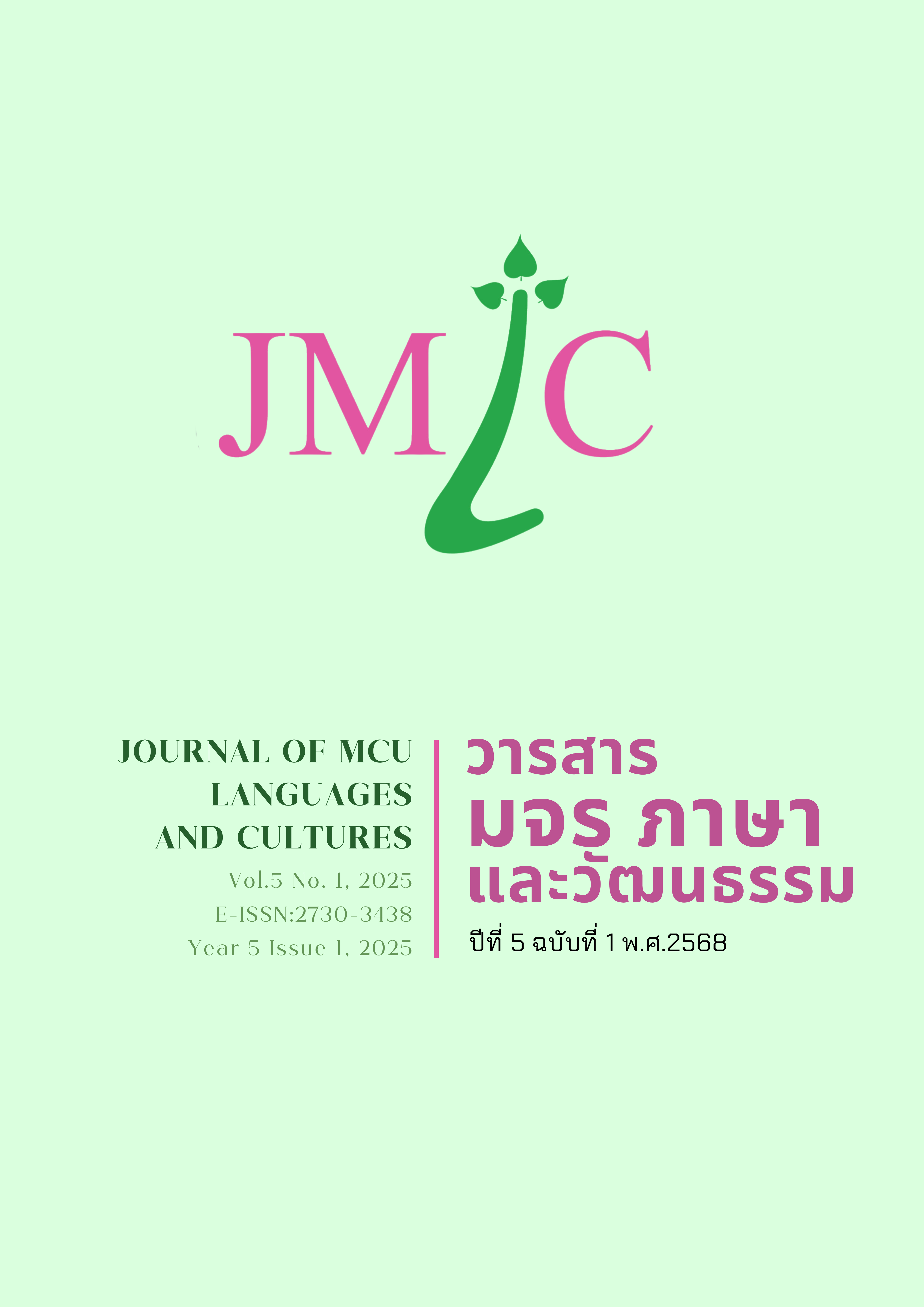Buddhist Methods of Communication for Peace: Communication Methods for Reducing Violence in Society
คำสำคัญ:
Buddhist Communication , methods for peace , communication, non-violenceบทคัดย่อ
The purpose of this article is to study Buddhist methods to determine the manner of expression towards violence. The study employs methods derived from research papers and academic articles to reflect, analyze, and analyze current situations. The study revealed that Buddhism has principles and practices that serve as mechanisms to show attitude (mindfulness) towards violent behaviors consisting of the concept of Buddhist communication methods illustrated the Abhaya Rajakumara Sutta, reducing bias from fear, anger, liking, and using the principles of “morality-concentration-wisdom” as a filter for liking and disliking, anger, not being angry, seeking benefits and leading to not seeking benefits, which are causes leading to violence, war and killing.
เอกสารอ้างอิง
Kowit Wongsurawat. (2016). The unfortunate Kurds of Kurdistan. Matichon Online, 28 November 2016. Online https://www.matichon.co.th/columnists/news_301053 Retrieved on 19 August 2019.
Chantra Hengsomboon. (2013). A comparative study of the views and practices of Buddhist peaceful methods and civil disobedience of the Santi Asoke community. Academic Humanities Journal, Faculty of Humanities, Kasetsart University.20 (2) July - December 2013 : 143-150.
Chalermpol Plomuk. (2018). Conspiracy Theory. Matichon Online: 19 April 2018 https://www.matichon.co.th/article/news_920097
Cholada Satchanit. (2009). “NTBs Measures; Non-Tariff Barrers (NTBs) : Key Trade Barriers for Thai Exports”. Sripathum Review: Humanities and Social Sciences. 9 (2) July-December 2009 : 125-134.
Chalat Pratuangratana. (2013). “Wrong Perception and Biased Thinking in Negotiation: How to Manage It?”. Sripathum Review: Humanities and Social Sciences. 13 (2), July-December 2013 : 115-122.
Tree Boonchuea. (2017). Media and Conflict Management on the “Wat Phra Dhammakaya” Case: An Analytical and Evaluation Study and developed for Thai society in the 4.0 era. NBTC Academic Journal. 2 (2017) : pp. 498-524.
Phramaha Harsa Thammahaso. (2014). Trends in the role of monks and Thai politics in the next two decades. Journal of Buddhist Studies, Chulalongkorn University. 21 (3), September-December 2014 : 29-54.
Phra Raphin Duangloi Buddhisaro, (2010). Violence at Buddha’s Time: A Study of Genocide of Sakya Clan. Thesis for Doctor of Philosophy in Buddhist Studies (Buddhism). Graduate School: Mahachulalongkornrajavidyalaya University.
Phutichatha Chanthakhun, Seri Chatcham, Witawat Penphu. (2019). Bias of Interest: “What I Believe to be True” Journal of Santhapol College. 5 (1) January-June 2019: 189-196.
Wanphan Manachotiphong. (2014). Looking at Yellow-Red through the Poles of Political Thought. Journal of Economics Thammasat. 32 (3) December 2014: 31-68.
Wilaiwan Chongwilaikasem. (2017). “Media (Does Not) Kill: Cultural Violence in the Digital Age”. Journalism, Faculty of Journalism and Mass Communication, Thammasat University. 10 (3) September-December: 153-163.
Srisupon Chuangsakun. (2019). The Concept of Dhammayuttika Nikaya: Rationalism and Humanism. Journal of Buddhist Studies Chulalongkorn University. 1 (2) : 54-81.
Somwang Kaewsuphong. (2016). The Caste System: Problems and Solutions from the Perspectives of Mahatma Gandhi and Dr. B. R Ambedkar. Journal of Panithan. 12 (2) July – December 2016 : 121-139.
Somwang Kaewsuphong. (2018). The Existence of the Caste System in Indian Society. Journal of Panithan. 14 (1) January - June 2018 : 115-134.
Surapot Thawisak. (2002). The Incident of B.E. 1: An Analysis of the Case of the First Council and the Bhikkhuni Sangha by Mettanando Bhikkhu, Journal of Buddhist Studies, Chulalongkorn University. 9 (2) : 82-92.
Surakrai Nantaburom, Walai Isarangkun Na Ayutthaya, (2015). “The Effects of Using Bias Reduction Activities Based on the Concept of Multicultural Studies on the Attitude and Understanding of Racial, Religious, and Cultural Diversity in the ASEAN Community of High School Students”. Journal of Education.43 (1) January-March 2015: 139-154.
Achaphurichan Nomnian. (2017). Social Concepts of Careers from the Perspective of Caste in Hinduism Journal of Public Administration. 6 (1), 31-60.
Asawin Netphokaew. (2014). “Social Media Innovation and the Biased Community”. Journal of Communication Arts and Innovation Management NIDA. 1 (1) July - December 2014 : 19-32.
Ekapolnat Natthaphatthanan. (2015). Color-shirt politics and the study of the counter-movement according to the tradition of studying social and political movements. Journal of Social Sciences, Chiang Mai University. 27 (1) : 85-128.
Amnuay Sukhi. (2017). The development of public participation in the political conflict crisis in Thailand between 2006-2014. Journal of Graduate Studies, Mahamakut Buddhist University. 15 (2) July-December 2017: 9-32.
Michael Schoenhals, ed., (1996). China's Cultural Revolution, 1966–1969: Not a Dinner Party. Armonk, N.Y.: M.E. Sharpe.
Chandler, David P. (1991). The Tragedy of Cambodian History. New Haven CT: Yale University Press.
G.S. Harris. (1977). Ethnic Conflict and the Kurds. Annals of the American Academy of Political and Social. Science, pp.118–120,
Longman, Timothy (2010). Christianity and Genocide in Rwanda. New York: Cambridge University Press.
Murray, Williamson; Woods, Kevin (2014). The Iran-Iraq War: A Military and Strategic History. New York: Cambridge University Press.
Yegar, Moshe (2002). "Between integration and secession: The Muslim communities of the Southern Philippines, Southern Thailand, and Western Burma/Myanmar". Lanham. Lexington Books.
Mamdani, Mahmood (2002). When Victims Become Killers: Colonialism, Nativism, and the Genocide in Rwanda. Princeton, NJ: Princeton University Press.
ดาวน์โหลด
เผยแพร่แล้ว
รูปแบบการอ้างอิง
ฉบับ
ประเภทบทความ
สัญญาอนุญาต
ลิขสิทธิ์ (c) 2025 วารสาร มจร ภาษาและวัฒนธรรม

อนุญาตภายใต้เงื่อนไข Creative Commons Attribution-NonCommercial-NoDerivatives 4.0 International License.






